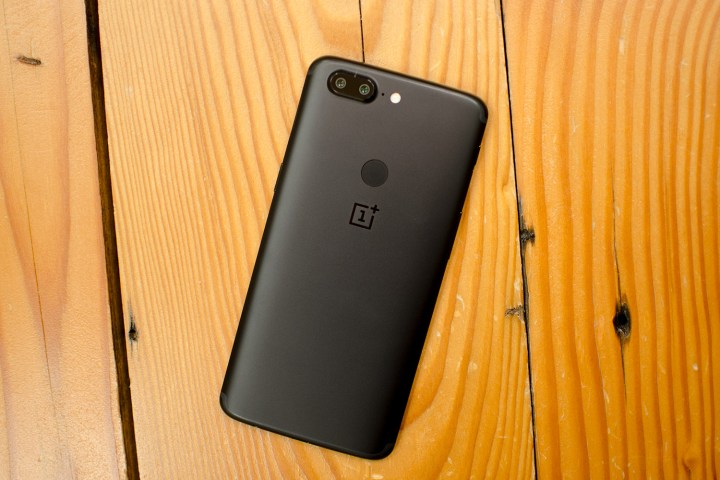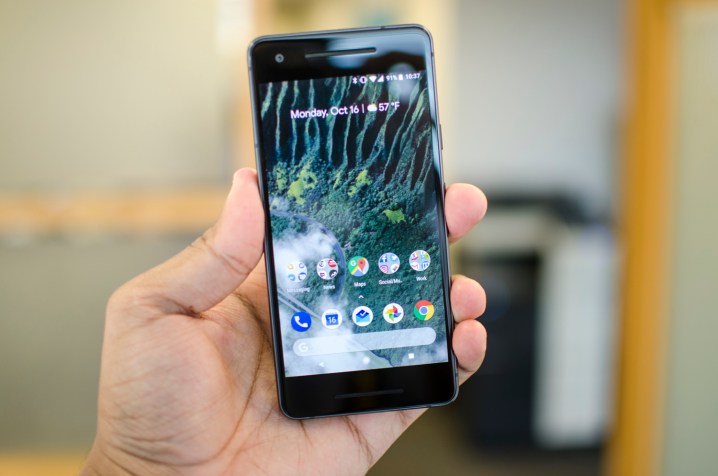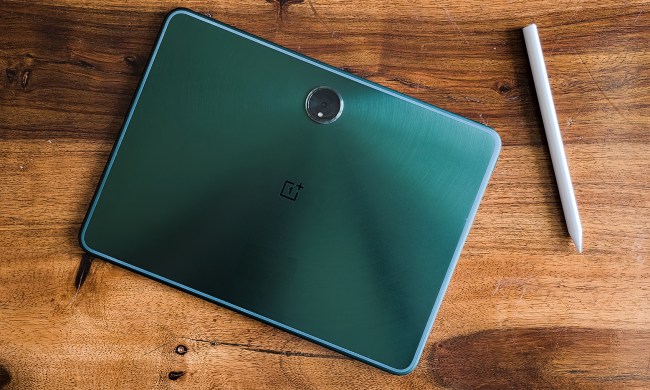
OnePlus has established a reputation for value, offering great specs at surprisingly low prices. But can a cheaper device from a smaller company measure up against the might of Google and its flagship? To find out, we took the newly revealed OnePlus 5T and put it head to head with the Pixel 2.
Specs
OnePlus 5T |
Pixel 2 |
|
| Size | 156.1 x 75 x 7.3 mm (6.15 x 2.95 x 0.29 inches) | 145.7 x 69.7 x 7.8 mm (5.7 x 2.7 x 0.31 inches) |
| Weight | 162 grams (5.7 ounces) | 143 grams (5.04 ounces) |
| Screen | 6.01-inch AMOLED | 5-inch AMOLED display |
| Resolution | 2,160 x 1,080 pixels (401 ppi) | 1,920 x 1,080 pixels (441 ppi) |
| OS | Android 7.1.1 Nougat | Android 8.0 Oreo |
| Storage | 64GB, 128GB | 64GB, 128GB |
| MicroSD card slot | No | No |
| NFC support | Yes | Yes |
| Processor | Qualcomm Snapdragon 835 | Qualcomm Snapdragon 835 |
| RAM | 6GB, 8GB | 4GB |
| Connectivity | GSM / CDMA / LTE | GSM / CDMA / HSPA / LTE |
| Camera | Front 16MP, Rear Dual 16MP and 20MP | 12.2 MP rear with OIS, 8 MP HD front |
| Video | 4K at 30 fps, 1080p at 60fps, 1080p at 30fps, 720p at 30fps, slow-motion 720p at 120fps | 4K at 30fps, 1080p at 120fps, 720p at 240fps |
| Bluetooth | Yes, version 5.0 | Yes, version 5.0 |
| Audio | Bottom-facing speaker, headphone jack | Stereo front-facing speakers, no headphone jack |
| Fingerprint sensor | Yes | Yes |
| Other sensors | Gyroscope, accelerometer, compass, proximity, | Barometer, gyroscope, accelerometer, compass, proximity sensor, Active Edge |
| Water resistant | No | Yes, IP67 |
| Battery | 3,300mAh | 2,700mAh |
| Charging port | USB-C | USB-C |
| Marketplace | Google Play Store | Google Play Store |
| Colors | Midnight Black | Black, Blue, and White |
| Availability | OnePlus | Google, Verizon |
| Price | $499 | $650 |
| DT review | Hands-on review | 4 out of 5 stars |
In terms of technological hardware, we’re looking at two very similar phones. The Pixel 2 and the OnePlus 5T both use Qualcomm’s Snapdragon 835 processor, which has become fairly standard for any 2017 flagship Android phone (the Note 8, LG V30, and Razer Phone all use the same processor). It’s a powerful little chip, and we expect great performance out of both of these handsets — though nothing that could really set them apart.
It’s a similar story with internal storage — both the Pixel 2 and the OnePlus 5T offer a 64GB model and an upgraded 128GB model. Neither has a slot for MicroSD card expansion, so think carefully before choosing one storage option over the other.
RAM is where we start to see a difference between the two. The Pixel 2 has a respectable 3GB of RAM, while the 64GB OnePlus 5T comes with 6GB of RAM and the 128GB model comes with a staggering 8GB. That is a lot of RAM — we have previously seen the same amount on the Razer Phone, but it’s still an exceptionally large amount. While the impact a large amount of RAM has on a phone is debatable, the extra brainpower on the OnePlus 5T should mean it will be a more capable multi-tasker than the Pixel 2.
Audiophiles will be happy to learn that both phones come with the additional signal strength and features of Bluetooth 5.0, but the OnePlus 5T has an advantage over the Pixel 2 with the courageous decision to continue supporting a headphone jack. We’ve seen many manufacturers drop the venerable port in the last year, and it’s nice that OnePlus is still fighting the good fight.
It’s a tight fight between these two smartphones where specs are concerned. While the extra RAM may be a relatively small advantage, it still scores the OnePlus 5T some points over the Pixel 2 — and the headphone jack seals it. The OnePlus 5T takes the win here.
Winner: OnePlus 5T
Design and display
The Google Pixel 2 may have cutting-edge flagship specs that can battle with the best of them, but the design falls somewhat short of 2017’s standard. Unlike the Pixel 2 XL, the Pixel 2 eschews the edge-to-edge display that we have seen many flagship phones adopt this year and it means that the Pixel 2’s large bezels look a little dated. However, it’s not a bad-looking phone, mirroring the iconic looks of the original Pixel phone, including the rear glass panel and fingerprint scanner. The 5-inch screen is an AMOLED display with a resolution of 1,920 x 1,080 pixels, and, as we’ve come to expect from OLED screens, it delivers a gorgeous picture with vivid colors and dark, inky blacks.
The OnePlus 5T is OnePlus’s first attempt at making a bezel-less phone, and the attempt has paid off — the OnePlus 5T is gorgeous. Unlike the Pixel 2, the 5T’s design is very 2017, with a massive 6-inch screen that dominates the front of the phone and shrinks the bezels to the very edges of the phone. The forehead and chin are reminiscent of the slim bands at the top and bottom of the Galaxy S8 and LG V30 (no Essential Phone or iPhone X-style notches here). The 6-inch screen is another AMOLED display, with an 18:9 aspect ratio and 2,160 x 1,080-pixel resolution. It was clear, sharp, and bright during our hands-on review, and we fully expect it to be just as good as the display in the Pixel 2. The only real downside to the OnePlus 5T is the massive camera bump. It extends a significant amount from the body, and it’s ugly. So many manufacturers have their cameras flush to the back, so why hasn’t OnePlus?
Moving on to durability, the Pixel 2 wins some points back with the addition of IP67 rated water-resistance, which means the Pixel 2 should be able to take a short trip into the bath or down the toilet. Unfortunately, the OnePlus 5T is lacking in any sort of water protection, so try not to take it swimming. OnePlus does win some points back with the full aluminum body — while we’re a fan of the Pixel 2’s unique glass band, we tend to worry about glass bodies on smartphones. Throw a case on it and it’ll be fine, though.
This is another tough category to call. While the OnePlus 5T brings a massive 6-inch display to the battle, the camera bump is such a turn-off. The Pixel 2 might have an older style, but it’s unique and we quite like it. The Pixel 2 also comes with water-resistance, meaning less potential time in a bag of rice. We’re judging this one a tie.
Winner: Tie
Camera
Peer into the OnePlus 5T’s cameras and you’ll find some serious snappers staring back at you. The dual lens-setup contains a 16-megapixel lens paired with a 20-megapixel lens, both with a wide f/1.7 aperture. If you’re familiar with the lenses on the previous OnePlus 5, then you will notice that the zoom lens has been replaced by the 20-megapixel lens — OnePlus says this is to help boost low light photography, but we are still disappointed to lose the optical zoom on the OnePlus 5T. We have yet to put the OnePlus 5T’s camera through our tests, but we anticipate that OnePlus’s good history with smartphone photography, as well as the solid numbers we’ve seen, should lead to a pretty impressive camera on the 5T.
Still, we can’t see it beating the Google Pixel 2’s camera. On paper, this seems like a mismatch; the Pixel 2 brings only a single 12-megapixel f/1.8 lens to the battle with OnePlus’s double shooters, but despite seeming outgunned, the Pixel 2’s camera is a serious contender for being the smartphone camera of the year. It broke DxOMark records when it launched, and we’ve seen the Pixel 2’s camera produce consistently fantastic photos with awesome color accuracy and a frighteningly good simulation of “bokeh” in the portrait modes.
Camera quality is where flagship smartphones are increasingly able to show off their pedigree, and while OnePlus has a great history with smartphone cameras, the 5T just can’t beat the incredible software contained in Google’s Pixel 2 camera. While we haven’t had the chance to test the 5T fully, we can’t anticipate it beating the Pixel 2 at this time, but we will update this if it turns out to be a Pixel-beater. For now, the Pixel 2 reigns supreme.
Winner: Pixel 2
Battery life and charging
Battery life is where it gets a little sketchy for the Pixel 2, with a 2,700 mAh battery. Our review tests found that moderate to heavy usage throughout the day would often leave the phone at around 20 percent at 7 p.m. That is a hard sell for a smartphone battery and it caused no end of battery-focused anxiety, and led to us carrying the charger around with us, topping up the battery where we could. Thankfully, the charger included in the box comes with Google’s fast-charging technology, which enables the battery to go from 15 percent to 65 percent in around 45 minutes. Still, we prefer a larger battery to make sure it can see through the day.
The OnePlus 5T’s battery is significantly larger than the Pixel 2, weighing in at a respectable 3,300mAh. We have yet to test the battery fully, but OnePlus is adamant that the 5T’s battery will match up to the performance of the OnePlus 5, which easily lasted the day on moderate usage, hitting 10 p.m. with just under 50 percent remaining — even light usage on the Pixel 2 saw it drop to 42 percent by 8 p.m. The OnePlus 5T also comes with the proprietary Dash Charge technology, which we saw give the OnePlus 5 60 percent in 30 minutes. It’s seriously impressive technology.
Thanks to the aluminum bodies on these phones, neither comes with wireless charging. Every hero has a chink in their armor, and the Pixel 2’s is in the battery area. The OnePlus 5T wins here with a larger battery and faster charging times.
Winner: OnePlus 5T
Software
The OnePlus 5T is Android 7.1.1 Nougat overlaid with Oxygen OS 4.7 — OnePlus’s custom Android skin. Ironically, it is a very similar experience to the stock Android you get on the Pixel devices, having few changes to the underlying Android. Still, there is a touch more customization than you can get on stock Android, and OnePlus has pared out some of the bigger additions to recent Android to keep the experience sleek and smooth — Google’s Daydream VR didn’t make the cut, and there’s no addition of a voice assistant outside of Google Assistant. You might also have noticed that the 5T isn’t running the latest version of Android — Android 8.0 Oreo. That is expected in early 2018, according to OnePlus.
As you would expect from the owner of Android, Google made sure the Pixel 2 comes with the latest Android software innovations. The Pixel 2 ships with Android 8.0 Oreo and the close integration between Google’s hardware and software means that Android runs buttery smooth on the Pixel 2; it’s possibly the best place to experience Android as it should be. But it’s not all about the stock Android experience — Google has added a few extra tidbits, just for the Pixel line. Active Edge is a new feature for the Pixel, fresh from HTC’s Edge Sense, and it allows you to activate your Google Assistant by simply squeezing the edges of your phone. It’s a small addition, and it’s mostly useful for areas where you don’t want to activate the Assistant with your voice. Other features, such as “Now Playing”, compares any music you might be listening to against an internal database, so you can be always sure what music is playing around you. There is very little that’s life-changing here; they’re very much quality of life improvements, but we appreciate them nonetheless.
The OnePlus 5T has a great stock Android-like experience, but the extra additions from Google in the Pixel 2 help to carry the day. The Pixel 2 wins here.
Winner: Pixel 2
Price and availability
The OnePlus 5T is set to release November 21, with prices starting from $500 for 64GB of storage and 6GB of RAM, and rising to $560 for the 128GB of storage and 8GB of RAM model. It will be sold exclusively on the OnePlus website, for now, while no U.S. carriers have announced deals for it. There is bad news for Verizon and Sprint customers, too — the OnePlus 5T has limited support on their networks, so it’s worth giving it a pass if you’re stuck with either of those two.
The Pixel 2 is currently available, with prices starting at $650 for 64GB of internal storage — the 128GB model will set you back a further $100. At the moment, Verizon has exclusivity on carrier sales, though you can buy the phone unlocked for use on any U.S. network, so that needn’t worry you if you’re a customer elsewhere. You can find all the purchasing options in our Pixel 2 buying guide.
We have to call this one a tie. The OnePlus 5T represents incredible value for money, but the lack of support for two major carriers makes it a tough sell within the U.S. The Pixel 2 is significantly more expensive, at $150 more at a base level — but it’s usable on every network.
Winner: Tie
Overall winner: Pixel 2
The OnePlus 5T is an incredible phone, and a worthy addition to OnePlus’s line of fantastic smartphones. However, it’s outmatched by the raw power of the Pixel 2. While the Pixel 2 may look dated, especially next to a phone as pretty as the OnePlus 5T, the experience of Android is second-to-none, it’s fast, and the camera is perhaps the finest we’ve seen to date.
Don’t get us wrong — if you don’t the budget for the Pixel 2 (and we totally sympathize with that), then you should not be ashamed to end up with the OnePlus 5T. It’s an amazing phone that will serve you well. But if you have the money for the Pixel 2, you should always be picking Google’s best over the OnePlus.







